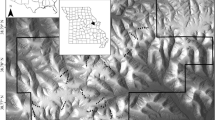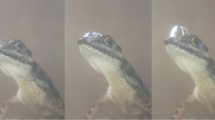Summary
The time until salamanders voluntarily abandoned foraging (the “water time limit”) and the amount of water lost when salamanders abandoned foraging (“dehydration deficit”) were determined for terrestrial plethodontid salamanders, Desmognathus ochrophaeus, foraging at various vapor pressure gradients in the laboratory. Salamander activity was correlated with the rate of water loss and was inversely related to the water time limit. Animals at 0.35–0.86 kPa vapor pressure gradients abandoned foraging and returned to moist retreats significantly sooner than animals in water-saturated air. The early retreat of animals in dry air was related in part to high rates of water loss and in part to the modest dehydration deficit (3.8%) at which animals abandoned foraging. Locomotor performance and foraging ability were unaffected by dehydration until dehydration deficits exceeded 12%. This suggests that salamanders in unsaturated air abandoned foraging at a low dehydration deficit to conserve and replenish water reserves rather than to avoid outright incapacitation or death.
Similar content being viewed by others

References
Bentley PJ (1966) Adaptations of Amphibia to to arid environments. Science 152:619–623
Beuchat CA, Pough FH, Stewart MM (1984) Simultaneous dehydration and thermal stress in three species of Puerto Rican frogs. J Comp Physiol (in press)
Feder ME (1983) Integrating the ecology and physiology of plethodontid salamanders. Herpetologica 39:291–310
Halliday TR, Sweatman HPA (1975) To breathe or not to breathe: the newt's problem. Anim Behav 24:551–561
Heatwole H (1960) Burrowing ability and behavioral responses to desiccation of the salamander, Plethodon cinereus. Ecology 41:661–668
Heatwole H, Torres F, de Austin SB, Heatwole A (1969) Studies on anuran water balance — I. Dynamics of evaporative water loss by the coqui, Eleuthrodactylus portoricensis. Comp Biochem Physiol 28:245–269
Hillman SS (1978) The roles of oxygen delivery and electrolyte levels in the dehydrational death of Xenopus laevis. J Comp Physiol 128:169–175
Jaeger RG (1978) Plant climbing by salamanders: periodic availability of plant-dwelling prey. Copeia 1978:686–691
Jaeger RG (1980a) Fluctuations in prey availability and food limitation for a terrestrial salamander. Oecologia (Berlin) 44:335–341
Jaeger RG (1980b) Microhabitats of a terrestrial forest salamander. Copeia 1980:265–268
Jaeger RG, Barnard DE (1981) Foraging tactics of a terrestrial salamander: choice of diet in structurally simple environments. Am Nat 117:639–664
Janzen DH, Schoener TW (1968) Differences in insect abundance and diversity between wetter and drier sites during a tropical dry season. Ecology 49:96–110
Keen WH (1979) Feeding and activity patterns in the salamander Desmognathus ochrophaeus (Amphibia, Urodela, Plethodontidae). J Herp 13:461–467
Keen WH (1982) Habitat selection and interspecific competition in two species of plethodontid salamanders. Ecology 63:94–102
Littleford RA, Keller WF, Phillips NE (1947) Studies on the vital limits of water loss in the Plethodont salamanders. Ecology 28:440–447
Porter WP, Mitchell JW, Beckman WA, DeWitt CB (1973) Behavioral implications of mechanistic ecology. Thermal and behavioral modeling of desert ectotherms and their microenvironment. Oecologia (Berlin) 13:1–54
Pough FH, Taigen TL, Stewart MM, Brussard PF (1983) Behavioral modification of evaporative water loss by a Puerto Rican frog. Ecology 64:244–252
Randall DJ, Burggren WW, Farrell AP, Haswell MS (1981) The Evolution of Air Breathing in Vertebrates. Cambridge University Press, Cambridge
Shoemaker VH, Nagy KA (1977) Osmoregulation in amphibians and reptiles. Ann Rev Physiol 39:449–471
Siegel S (1956) Nonparametric Statistics for the Behavioral Sciences. McGraw-Hill, New York
Spotila JR (1972) Role of temperature and water in the ecology of lungless salamanders. Ecol Monogr 42:95–125
Spotila JR, Berman EN (1976) Determination of skin resistance and the role of the skin in controlling water loss in amphibians and reptiles. Comp Biochem Physiol 55A:407–412
Tracy CR (1975) Water and energy relations of terrestrial amphibians: insights from mechanistic modelling. In: Gates D, Schmerl D (eds) Perspectives in Biophysical Ecology. Springer, Berlin Heidelberg New York, pp 325–346
Tracy CR, Welch WR, Porter WP (1980) Properties of Air: a Manual for Use in Biophysical Ecology, 3rd ed. The University of Wisconsin, Madison
Author information
Authors and Affiliations
Additional information
Present address: Department of Zoology, University of Guelph, Guelph, Ontario N1G 2W1, Canada
Rights and permissions
About this article
Cite this article
Feder, M.E., Londos, P.L. Hydric constraints upon foraging in a terrestrial salamander, Desmognathus ochrophaeus (Amphibia: Plethodontidae). Oecologia 64, 413–418 (1984). https://doi.org/10.1007/BF00379141
Received:
Issue Date:
DOI: https://doi.org/10.1007/BF00379141



